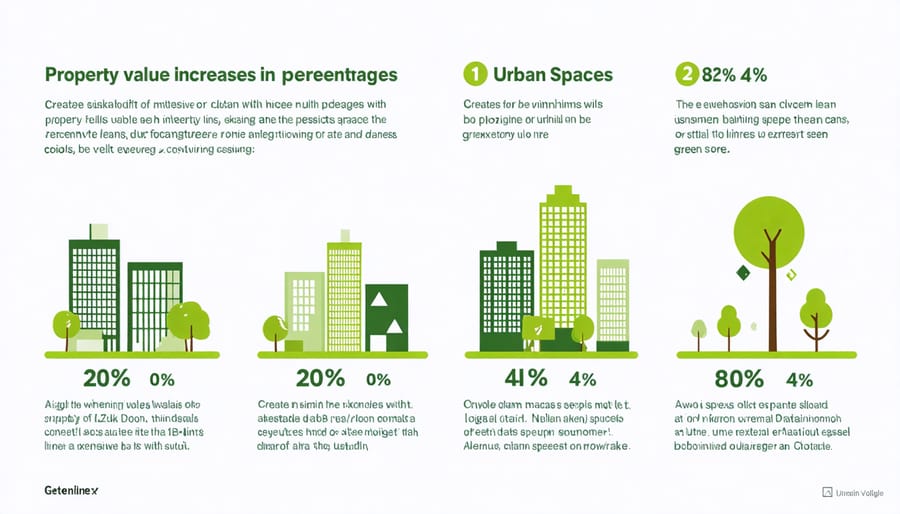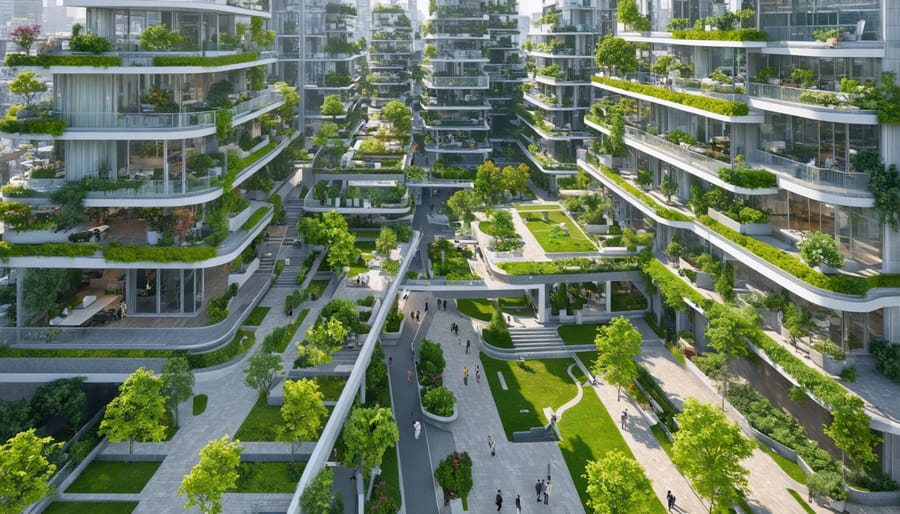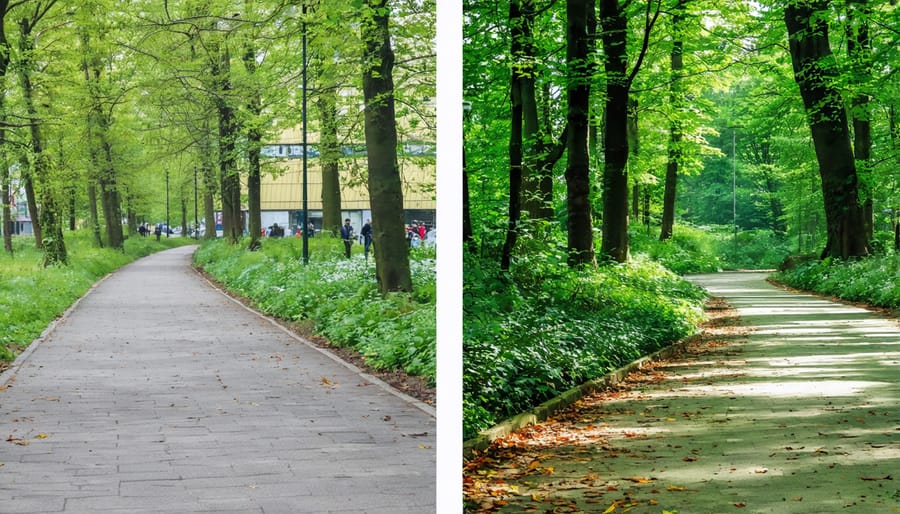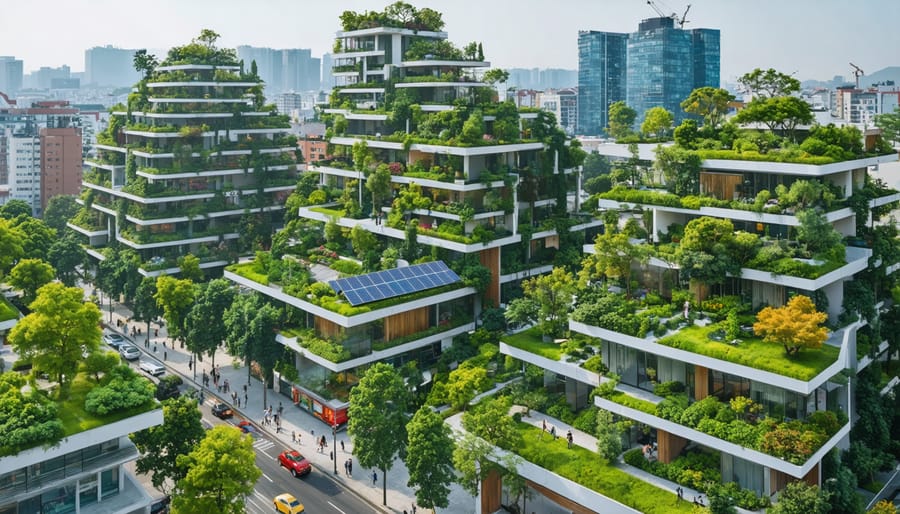Green infrastructure integration represents a critical shift in modern urban development, transforming cities from concrete expanses into resilient, livable environments. As metropolitan areas grapple with climate change, air quality concerns, and rising mental health challenges, strategic implementation of green spaces has emerged as a cornerstone of urban resilience planning. Recent data demonstrates that cities incorporating at least 30% green space coverage experience a 15% reduction in urban heat island effects and an 8% improvement in air quality metrics.
The economic implications are equally compelling: property values adjacent to well-designed urban parks increase by 20% on average, while strategic green infrastructure can reduce stormwater management costs by up to 25%. For construction professionals and urban planners, this represents not just an environmental imperative but a significant return on investment opportunity that shapes the future of urban development.
This technical analysis explores cutting-edge approaches to integrating green spaces within high-density urban environments, examining both the engineering challenges and innovative solutions that define successful implementation strategies.
The Economic Case for Urban Green Spaces
Property Value Enhancement
Recent market analyses demonstrate that strategically placed green spaces significantly impact property values in urban environments. According to a comprehensive study by the National Association of Realtors, properties adjacent to well-maintained parks and green spaces command a premium of 8-20% compared to similar properties without proximity to such amenities.
In high-density urban areas, the impact is even more pronounced. Research from the Urban Land Institute reveals that commercial properties within a quarter-mile radius of quality green spaces experience an average value increase of 15-25%. Additionally, residential properties overlooking urban parks show a remarkable 30-40% price premium compared to properties just two blocks away.
Data from major metropolitan areas indicates that every $1 invested in urban green space development yields approximately $7 in increased property values within a five-year period. This multiplier effect extends beyond immediate surroundings, creating value appreciation zones that can span up to half a mile from the green space.
For developers and investors, these statistics present compelling evidence for incorporating green spaces in urban development projects. Cities like Chicago and New York have documented 50-100% returns on investment through increased property tax revenues from areas surrounding newly developed urban parks and green corridors.

Operational Cost Benefits
Green spaces adjacent to urban buildings deliver substantial operational cost benefits through multiple pathways. Studies show that strategic placement of vegetation can reduce building energy consumption by 20-30% annually. This reduction stems primarily from natural cooling effects, which decrease air conditioning demands during summer months and provide windbreak benefits in winter.
According to research by the Urban Green Council, buildings surrounded by green spaces demonstrate improved sustainability metrics and reduced maintenance costs. The natural filtering effect of vegetation reduces particulate matter reaching building facades, extending the lifespan of exterior finishes and decreasing cleaning frequency.
Proper implementation of green spaces can optimize stormwater management systems, reducing infrastructure strain and associated maintenance costs. Buildings with integrated green spaces typically experience 30-50% lower stormwater management expenses compared to traditional urban developments.
Additionally, green spaces contribute to extended roof life expectancy by protecting membrane systems from UV damage and temperature fluctuations. This protection can extend roof service life by up to 200%, resulting in significant long-term cost savings. When combined with smart irrigation systems and drought-resistant plant selection, these spaces require minimal ongoing maintenance while maximizing operational benefits.

Technical Implementation Strategies
Infrastructure Requirements
The development of sustainable urban green spaces requires a robust infrastructure framework that supports both immediate implementation and long-term maintenance. Essential components include irrigation systems with smart controllers and moisture sensors, which optimize water usage while maintaining plant health. These systems should integrate with existing municipal water networks and incorporate rainwater harvesting capabilities.
Soil management infrastructure is crucial, requiring engineered growing media that balances drainage, water retention, and nutrient availability. Sub-surface structural systems, such as silva cells or suspended pavement systems, are necessary to support healthy root growth beneath paved areas while managing stormwater runoff.
Lighting infrastructure must meet both safety requirements and ecological considerations. LED systems with motion sensors and programmable controls reduce energy consumption while minimizing light pollution that could affect local wildlife. Power distribution networks should accommodate both maintenance equipment and public amenities.
Access infrastructure requires careful planning, including permeable pathways, maintenance vehicle routes, and universal design elements. Load-bearing calculations must account for various surface treatments and underground utilities, while ensuring compliance with accessibility standards.
Drainage systems demand particular attention, incorporating bioswales, retention basins, and pervious surfaces. These elements should connect to existing stormwater infrastructure while providing natural filtration and groundwater recharge capabilities.
Maintenance facilities, though often overlooked, are essential infrastructure components. These include storage areas for equipment and materials, composting facilities, and dedicated water sources for landscape maintenance. Additionally, monitoring systems for tracking environmental conditions, usage patterns, and infrastructure performance should be integrated into the overall design to enable data-driven management decisions.
Integration with Existing Structures
Integrating green spaces into established urban environments requires strategic planning and innovative design solutions that complement existing infrastructure. Modern approaches focus on maximizing underutilized spaces while ensuring seamless smart city infrastructure integration.
Vertical integration has emerged as a primary solution, incorporating green walls and rooftop gardens into existing buildings. These systems typically require structural assessment to ensure load-bearing capacity and may necessitate retrofitting with appropriate irrigation and drainage systems. Building-integrated vegetation can be implemented through modular systems that attach to existing façades or through purpose-built frameworks that support climbing plants.
Adaptive reuse of obsolete infrastructure presents another viable approach. Abandoned railway lines, unused parking structures, and defunct industrial sites can be transformed into linear parks, elevated gardens, or community green spaces. This method often requires soil remediation and the installation of specialized growing medium systems to ensure plant viability.
Pocket parks represent an effective strategy for utilizing small, irregular spaces between buildings. These micro-green spaces can be created through the conversion of unused lots or the reconfiguration of oversized streets and intersections. Implementation typically involves permeable paving systems, strategic placement of containerized plantings, and integration of sustainable drainage solutions.
Underground infrastructure must be carefully considered when retrofitting green spaces. This includes mapping utility lines, assessing root barriers, and implementing protective measures to prevent interference with existing systems. Success often depends on close collaboration between structural engineers, landscape architects, and urban planners to ensure technical feasibility while maximizing environmental benefits.
Biodiversity Planning Essentials
Species Selection Criteria
Selecting appropriate species for urban green spaces requires careful consideration of multiple environmental and practical factors. Native species should generally comprise 60-70% of plantings, as they are better adapted to local climate conditions and support existing ecosystems. Consider the mature size of plants, their growth rates, and maintenance requirements when making selections.
For trees, priority should be given to species with high pollution absorption capabilities and effective carbon sequestration rates. Species like Tilia cordata (Small-leaved Lime) and Platanus x acerifolia (London Plane) have proven particularly effective in urban environments. Ensure selected species have adequate root space and won’t interfere with underground utilities or surface infrastructure.
Ground cover and shrub selections should focus on drought-resistant varieties that require minimal irrigation. Species should demonstrate resilience to urban stressors, including heat island effects, soil compaction, and air pollution. Consider seasonal variations to maintain year-round visual interest and biodiversity support.
Wildlife-supporting species should be incorporated to create sustainable urban ecosystems. Select plants that provide food and shelter for local bird populations and pollinators. However, avoid species known to attract problematic wildlife or those with invasive tendencies that could threaten local biodiversity.
Maintenance requirements must align with available resources. Species selection should account for local climate projections, considering potential changes in temperature and precipitation patterns over the next 50 years to ensure long-term viability.
Maintenance Protocols
Maintaining biodiversity in urban green spaces requires a systematic approach that balances ecological needs with urban functionality. Regular monitoring of plant health indicators, soil quality, and wildlife populations forms the foundation of effective maintenance protocols. Construction professionals should implement seasonal maintenance schedules that include native species preservation, invasive species control, and habitat protection measures.
Key maintenance practices include strategic pruning during dormant seasons, controlled irrigation systems that optimize water usage, and integrated pest management techniques that minimize chemical interventions. Soil management protocols should focus on maintaining organic matter content through composting and mulching, while avoiding compaction in root zones.
For maximum biodiversity support, maintenance teams should establish designated “wild zones” within green spaces where natural processes can occur with minimal intervention. These areas should comprise approximately 20-30% of the total green space, creating essential wildlife corridors and natural habitat patches.
Infrastructure maintenance must consider wildlife patterns, with lighting systems designed to minimize disruption to nocturnal species and drainage systems that support natural water flow patterns. Regular assessment of habitat connectivity ensures that green spaces continue to function as effective ecological networks within the urban matrix.
Documentation of maintenance activities, including species monitoring data and intervention outcomes, helps optimize future management strategies and supports evidence-based decision-making for urban biodiversity conservation.
Case Study: The Manchester Green Corridor Project
The Manchester Green Corridor Project stands as a landmark example of innovative urban revitalization strategies, transforming 6.5 kilometers of underutilized urban space into a thriving green corridor that connects the city center to its northern suburbs.
Implemented in 2019 with a £23 million investment, the project demonstrates how strategic green space planning can address multiple urban challenges simultaneously. The corridor incorporates sustainable drainage systems (SuDS), biodiversity zones, and multi-use pathways, serving both ecological and social functions.
Key technical specifications of the project include:
– Installation of 12,000 square meters of permeable paving
– Integration of 45 rain gardens for natural water management
– Planting of 1,200 native trees and 85,000 square meters of diverse vegetation
– Implementation of smart sensors for irrigation and maintenance monitoring
The project’s success is evidenced by measurable outcomes:
– 32% reduction in local surface water runoff
– 45% increase in biodiversity indices
– 28% improvement in local air quality measurements
– 65% increase in pedestrian and cyclist traffic
The financial model combines public-private partnership funding with innovative maintenance solutions. Annual maintenance costs are offset by community adoption programs and corporate sponsorship of specific zones, ensuring long-term sustainability.
Particularly noteworthy is the project’s phased implementation approach, which allowed for continuous public access and minimal disruption to existing infrastructure. The construction team employed modular green infrastructure elements, enabling rapid installation and future adaptability.
Challenges encountered during implementation included soil contamination in former industrial areas and coordination with existing utility infrastructure. These were addressed through innovative soil remediation techniques and careful mapping of underground services, providing valuable lessons for similar urban projects.
The Manchester Green Corridor Project demonstrates how well-planned green infrastructure can deliver multiple benefits while maintaining cost-effectiveness and practical functionality. Its success has influenced similar initiatives across the UK and Europe, establishing new benchmarks for urban green space development.

The successful implementation of green spaces in urban environments requires a strategic, multi-faceted approach that combines careful planning, sustainable design principles, and stakeholder collaboration. As our cities continue to evolve, the integration of green infrastructure has proven to be not just an environmental necessity but a sound investment in urban development.
Key implementation strategies that have demonstrated consistent success include phased development approaches, early stakeholder engagement, and the adoption of smart technologies for maintenance optimization. Construction professionals should prioritize the selection of native plant species, implement efficient irrigation systems, and utilize sustainable materials that complement existing urban infrastructure.
Looking ahead, the future of urban green spaces appears promising, with emerging technologies and innovative design solutions offering new possibilities. The industry is witnessing increased adoption of vertical gardens, bioswales, and smart monitoring systems that enhance the efficiency and sustainability of green spaces. Additionally, government initiatives and environmental regulations are increasingly supporting the expansion of urban greenery.
To ensure long-term success, construction professionals must focus on creating adaptable designs that can respond to changing climate conditions and urban needs. This includes incorporating resilient infrastructure elements and maintaining flexibility in space utilization. The integration of data-driven maintenance systems and sustainable management practices will be crucial for the longevity and effectiveness of these vital urban assets.
The continued evolution of green space development will rely heavily on industry collaboration, technological advancement, and commitment to sustainable urban planning principles.

